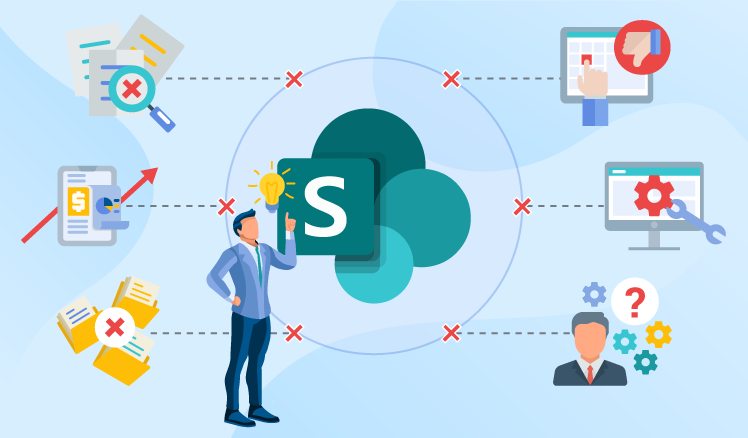6 Myths about SharePoint Disadvantages Busted
SharePoint is a powerful collaboration platform with a strong user base due to the platform’s high flexibility, scalability and customizability. However, many users point out to a number of disadvantages of the platform.
Having worked with SharePoint for 16 years, we’ve investigated these complaints inside and out. We’ve come to a conclusion that the majority of these complaints are just myths that arise from wrongful SharePoint implementation or administration, and we’re going to dispel 6 most common ones.

Myth #1: Poor search functionality
Many users accuse SharePoint of ineffective search. For example, they claim that SharePoint doesn’t return results even when they know that certain content has been added. Also, search results can be hard to find and be irrelevant, and query response time can be slow.
Myth debunked:
SharePoint has advanced search capabilities. For example, such features as taxonomy, indexing and metadata are responsible for making content easily searchable and accessible. Additionally, SharePoint can be integrated with AI to enable users to see search suggestions upon typing a query into a search box. However, SharePoint search can’t be as effective as, say, Google search without proper configuration and regular optimization. Thus, how the search works depends on a SharePoint admin’s skill.
Myth #2: Non-intuitive interface
Users claim that the SharePoint default interface is mundane and plain. They also say SharePoint is inconvenient to utilize, which hinders user adoption.
Myth debunked:
This is a common problem of uncustomized or poorly customized SharePoint solutions. However, the platform itself is very flexible and enables creating user-friendly and engaging interfaces tailored to users’ needs. For example, to make the content on a SharePoint page easier to perceive, a ribbon, left-hand navigation and a footer can be eliminated from SharePoint sites with the help of customization. As for making a SharePoint solution more engaging and encourage wider use, custom branding can be of help.
Myth #3: Complicated customization
It’s a popular belief that end users can’t customize SharePoint by themselves as, for example, SharePoint customization via Visual Studio requires strong programming skills.
Myth debunked:
After the release of PowerApps and Microsoft Flow, customization became manageable even for users without deep technical knowledge. These tools help users to easily create custom forms and automated workflows. For example, Microsoft Flow offers a gallery of templates that can be used to create various workflows like moving a file into a different folder after approval.
Myth #4: Feature redundancy
Users struggle to master and get value from all SharePoint features. Moreover, in case of SharePoint Online, Microsoft releases frequent updates that may confuse users. So, it seems that the motto “If you build it, they will come” doesn’t work for SharePoint.
Myth debunked:
Here the problem is at the organizational level: lack of a robust change management strategy, professional IT consulting services and proper training. Without this package, users and admins won’t be able to make the most of the platform and SharePoint adoption will most probably fail.
Myth #5: Messy storage
Many users notice that, after a certain time, a SharePoint solution always ends up turning into a mess. It becomes difficult to find digital assets there, especially if they are misplaced or duplicated.
Myth debunked:
The actual problem is in the lack or poor governance policies that stipulate who can create, update and delete SharePoint content. Also, implementing automated content retention and deletion policies are crucial for keeping order in SharePoint libraries.
Myth #6: High total cost of a SharePoint solution
It seems disappointing to many that, although SharePoint subscription plans start at $5.00, the total cost of SharePoint implementation can be as high as $200,000 due to additional expenses on data migration, integrations, customizations, workflows and more.
Myth debunked:
With thorough IT consulting on SharePoint implementation attending to a company’s business needs and an allocated budget, a SharePoint solution will not cost a fortune. For example, implementation costs can be reduced due to advising to use out-of-the-box SharePoint functionality where possible, providing conducting the value/cost analysis, and opting for an iterative development path.
Real or make-believe disadvantages?
When looking deeper into the reasons why users hate SharePoint, we see that they are usually caused by improper SharePoint implementation, configuration or use. So, our advice is to entrust skilled SharePoint specialists with the task of SharePoint configuration and administration for the solution to bring you flawless operation and maximum value.

